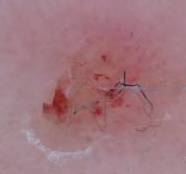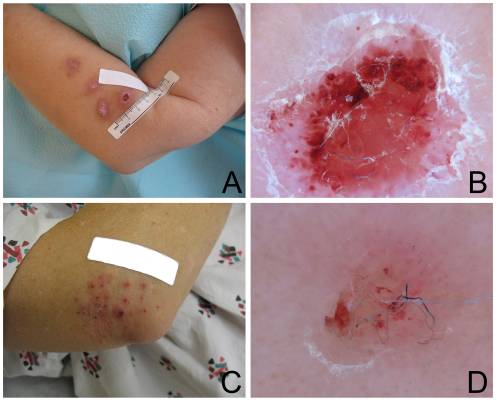 Morgellons Syndrome is described as a skin ‘infestation’ by small mites, or morgellons. The ‘diagnosis’ is not accepted by mainstream medicine but has been widely publicized by media outlets and advocacy groups. Those who are believed to have morgellons complain of itchy skin, stinging and painful sensations, and the feeling of creeping and crawling underneath the skin. In many patients, there are persistent skin infections that do not heal properly. Some describe white plaques the form around chronic skin wounds. One of the unifying complaints, however, is the presence of small fibers erupting from the skin after the symptoms have been present for a few weeks.
Morgellons Syndrome is described as a skin ‘infestation’ by small mites, or morgellons. The ‘diagnosis’ is not accepted by mainstream medicine but has been widely publicized by media outlets and advocacy groups. Those who are believed to have morgellons complain of itchy skin, stinging and painful sensations, and the feeling of creeping and crawling underneath the skin. In many patients, there are persistent skin infections that do not heal properly. Some describe white plaques the form around chronic skin wounds. One of the unifying complaints, however, is the presence of small fibers erupting from the skin after the symptoms have been present for a few weeks.
Initial research into these complaints identified no unifying cause, no parasite, and no underlying cause. The lack of evidence for morgellons led most medical organizations, including the American Academy of Dermatology, to declare the the symptoms were not skin related at all, but were a delusion. The combination of symptoms, they say, follows a well known pattern that has been described in dermatology as Delusional Parasitosis: a disease that causes a healthy person to have a strong and incurable belief that their bodies are being overtaken by mites or bugs. Interestingly, a PubMed search of all research that has been published on the subject (34 papers since 2006) identified no causative factor but did include titles with words such as: psychosis, hypnosis treatment, delusion, unexplained, antipsychotic-responsive, mysterious, web-based dissemination, contested, unknown etiology, and internet meme. [CLICK HERE TO SEE ALL 34 PAPERS]
Nevertheless, though the medical community has shunned the idea of morgellons, the diagnosis has lived on. A recent paper published in PLoS One identified the epidemiology of 115 patients who were thought to have morgellons syndrome. The paper found that 70% of these patients also complained of chronic fatigue, 59% had cognitive deficits, 50% tested positive for drugs, and 78% reported exposure to solvents. Quite the motley crew! However, they did find some interesting results among this interesting group, see images below…
Something is certainly going on in those images. Is it a delusion? Or is it a whole body infestation?










 My name is Andrew and I am a first year resident training to be an ophthalmologist. I created ShortWhiteCoats to provide medical students, residents, and the public with all the information I spent so many hours looking for during medical school.
My name is Andrew and I am a first year resident training to be an ophthalmologist. I created ShortWhiteCoats to provide medical students, residents, and the public with all the information I spent so many hours looking for during medical school.







